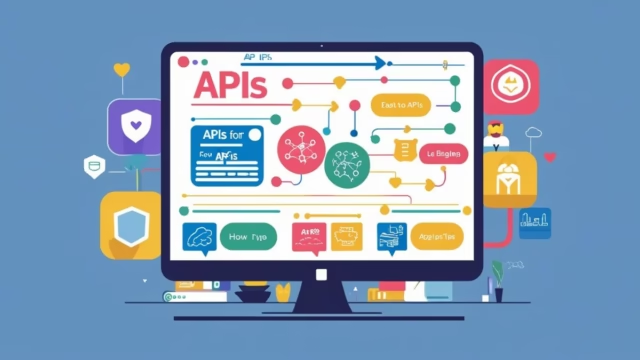Introduction
Application Programming Interfaces are referred to as API and they enable other software systems to interact with other systems. We can imagine them as digital messengers between programs that transmit requests and answers. When you check the weather using a phone-based app, sign up or log in using Google, or listen to music, APIs are what allow it to happen right behind the curtains.
As a learning APIs can give you access to incorporating such potent services in your apps or websites. Software is made more interactive, efficient, and scalable by APIs in the current, technology-driven world. Acquiring the knowledge of their usage is one of the essential skills of any future developer.
Why API matters?
APIs matter as they are the foundation of how software applications interact and communicate with each other. Here’s a breakdown of why APIs are important:
1. Invisible Marriage of Services
The current software integration relies on APIs. They enable various services and applications to interact in a way whereby they do not need to know all the internal processes of one another. To illustrate, an airline or hotel database is the source of data pulled by a travel booking site; in this case, the travel booking site is making use of APIs.
This makes the communication efficient, less complex, and also allows developers to develop feature-rich applications much quicker. APIs ease communication between the digital service and cross-platform third-party services and enhance the whole digital environment to be more joined and productive.
2. Greater Productivity of Developers
APIs allow developers to reuse the code and utilise pre-designed features, including payment gateways, authentication systems, and messaging services. Developers do not have to do everything anew, as they can just call an API. This speeds up the cycle of development, results in fewer bugs, and promotes more regularity between applications.
As another example, it is just a matter of making a handful of API calls to incorporate Google Maps into an application instead of creating a mapping infrastructure. APIs eliminate the need to reinvent the wheel and increase developer efficiency quite remarkably.
3. Empowerment of Automation and Efficiency
APIs are considered to be the heart of automation and the facilitation of work. APIs allow businesses to integrate various applications such as CRMs, email tools, and data dashboards so that they may exchange information automatically. This makes the process of data entry less time-consuming and error-prone. As an example, APIs will enable synchronization between your e-commerce store and inventory management software in real-time.
Types of APIs
APIs come in different types based on their access level, purpose, and architecture. Here’s a breakdown of the main types of APIs:
1) Public APIs (Open APIs)
An open API or a Public API is published to the outside and it allows maximum use to outside users. The APIs are to be consumed by everyone and are usually made available by companies interested in publishing their services or data to the world. An example is Twitter and Google Maps, both of which have friendly APIs that can be used by the developer to add location and social media functionalities to the applications. Open APIs allow businesses to expand their ecosystems, open up to new users, and induce innovation because they enable the building of features on their platforms by third-party developers.
2) Internal APIs (Private APIs)
These APIs are used to share and combine data within an internal system, department, or combined applications. As an illustration, the HR system of a company can have an internal API based on which they are connected to payroll or employee performance systems.
They are usually more controllable in regards to security, updates, and compatibility since they are restricted in use to within their means. Internal APIs enhance modularity, scalability, and the rate of development of an organization, but do not expose its sensitive data to the external world.
3) Partner APIs
Partner APIs are distributed to partnered businesses, and these are subject to verification or licensing agreements. They are usually used to help businesses collaborate securely and manage their interaction. An example is that a shipping service may offer an API to a retail customer to be able to track packages or instantly compute shipping rates.
Partner APIs present a compromise between the openness of the public APIs and the constraints of the internal APIs, giving companies an option to establish alliances and build up integrated service offerings while managing the data.
4) REST, SOAP, GraphQL Web APIs
The most prevalent type is Web APIs, which are used to communicate on the internet, typically using such protocols as HTTP. The most popular of them is REST (Representational State Transfer) because it is simple and scalable. SOAP (Simple Object Access Protocol) is more formal and widely used in enterprises.
GraphQL is a new query language created by Facebook that enables clients to request only the data they want. All of them have different benefits in their use cases, like being flexible, having good performance, or being very schema-intensive.
5) Composite APIs
Composite APIs aggregate a set of service or data API requests into one. They are particularly helpful when used in microservices architecture, where a single task can make use of data collected by various sources.
To give an example, a composite API would be able to fetch the data of a user profile, previous purchases, and payment histories at the same time. This minimizes the API calls as well as enhances performance, particularly in the case of mobile or web applications where latency is a major factor. Composite APIs make the workflows simpler and applications more responsive and efficient.
Basics of API Architecture
Client-Server Model
The client-server model is the basis of API architecture. It splits the system into two separate entities: the client (consumer) and the server (provider). The client will send requests to the server, which will then process those and give the right response. Such segregation of roles enables the client and the servers to be developed independently and is more scalable and maintainable.
As an example, a mobile client (client) can request user data from a server through an API. The given model enables platform-agnostic development, which means that the same server logic may be accessed using web, desktop, and mobile clients. The decisive separation of UI (frontend) and data processing (backend) fosters high software architecture efficiency.
RESTful Architecture
Representational State Transfer (REST) is a well-liked architectural style of designing networked applications. RESTful API communicates through the standard HTTP protocols (GET, POST, PUT, and DELETE) to manage the resources described by a URL.
The key feature of REST is statelessness that is, every client request should provide all the information necessary to interpret and act upon a request. REST is also based on a standard interface, which is usually based on JSON. It is simple, scalable, and common to use, and therefore a favorite among modern APIs.
The REST APIs are convenient to handle and test, and thus can be used in a web or mobile application where a particular interface needs a reliable connection to the service.
Resources and API Endpoints
An endpoint is a particular route in an API that denotes a kind of resource, like a user, a product, an order, and so on. Every endpoint is linked to a URL and responds to distinct requests depending on the provided HTTP approach.
As an example, an endpoint get /users will retrieve data about existing users, and post users will create new ones. Resources usually follow the JSON or XML representation, so the parsing data becomes easy for the clients on how to render the same. It is important to organize the endpoints logically and consistently as far as API usability and maintenance are concerned.
Authorization and authentication
The aspect of security is vital in the architecture of the API. Authentication can be seen as confirming who the client is (e.g., via API keys, OAuth, or JWT), and authorization determines what a user can and cannot access. As an example, a user can be authenticated using an access token, but may only be able to read their information and not update that of others.
APIs tend to encrypt the data using HTTPS, and sometimes they rate limit to mitigate abuse. Adequate use of authentication and authorization guarantees the safety of sensitive information and that it is viewed by the appropriate individuals or computers, and upholds the integrity and confidentiality of the API.
How APIs Work (Step-by-Step)?
Below is a step-by-step explanation of how APIs work, broken down in simple terms:
1. Request Initiation
An interaction between two parties in an API involves a request to an API made by a client, e.g., a web or mobile application, to the server on which it is hosted. A common action of initiating this request is an HTTP method (GET, POST, PUT, DELETE), and the destination is an API endpoint.
The client can put in more parameters, headers, or a body in (as in POST/PUT) to determine what data it desires to fetch or send. We can see the example when a GET /users/1 request retrieves the information about one user (ID 1). This is the step where the client will form its data communication framework and structure.
2. Request being processed by the Server
As soon as the request has been received by the server, it analyses it by using its internal logic. This involves checks like verifying the method of the request made, parameters, authentication, and an access control check.
In case of a legitimate request, the server runs a necessary operation, reads a piece of data out of a database, runs a piece of business logic, or modifies a record. In case of an error (e.g., inaccessible permission or incorrect data), the server responds accordingly with an error message. This is done to maintain the integrity of the operations and security, and this stands as the backbone of reliable and logical communication.
3. Response Formulation
Once they are processed, the server responds to the client in a structured manner. Such a response usually consists of a status code (e.g., 200 OK, 404 Not Found, 401 Unauthorized) and the result or error message formatted in JSON or XML body. Such as when an effective GET /users/1 request returns a JSON object containing such user details as name, email, and other information.
Well-formatted answers give the client an understanding of whether this request is successful or requires a correction. This action forms a loop in communication between the client and the server.
Conclusion
APIs are the tools that make the interaction between the various software systems efficient and reliable. They simplify complicated operations by providing a standardized interaction point between users and data and functionality that is required in the current application development.
Learning to innovate and collaborate with ease by first becoming familiar with the fundamentals of creating and connecting in the digital world, whether it be type and architecture, or the step-by-step process of how all these things work. It is not only one of the tools, but APIs are the language of the contemporary world of technology.







Your writing is a true testament to your expertise and dedication to your craft. I’m continually impressed by the depth of your knowledge and the clarity of your explanations. Keep up the phenomenal work!